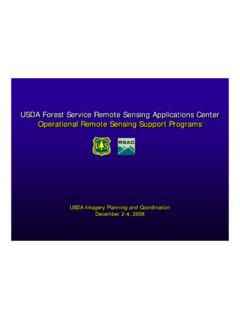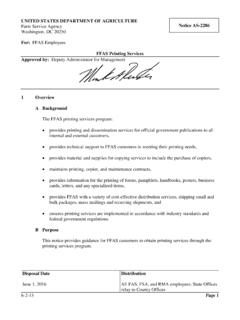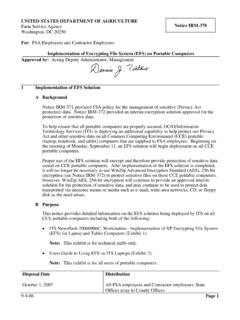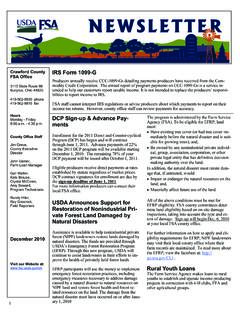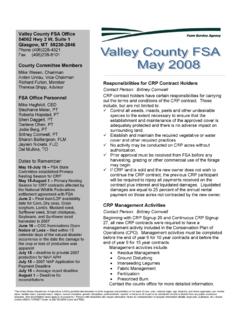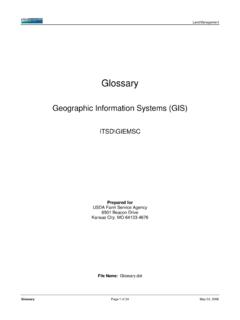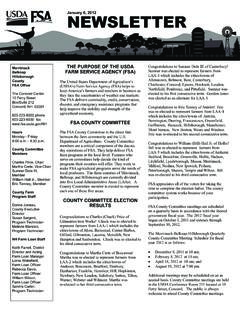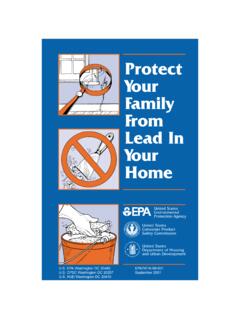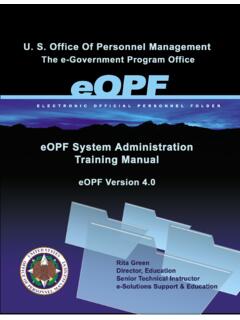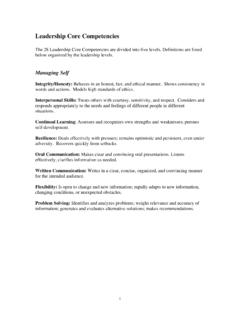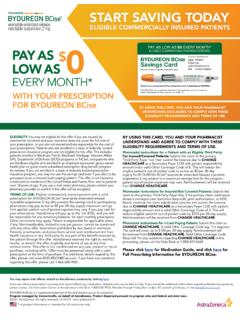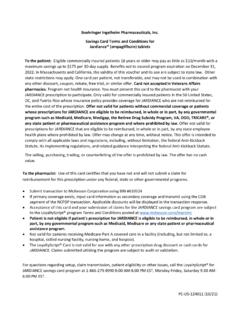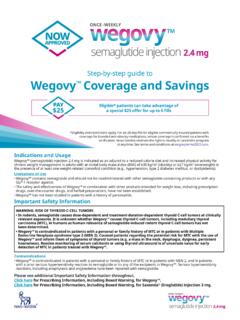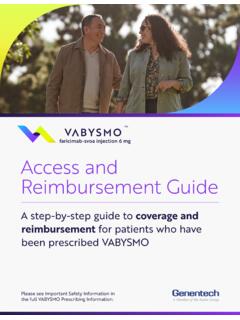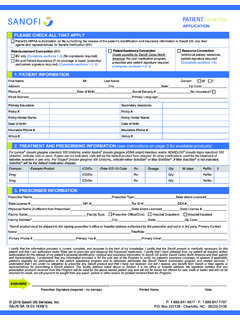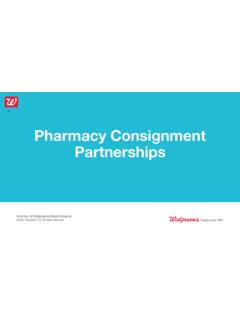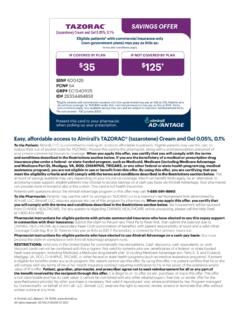Transcription of DISASTER ASSISTANCE - Farm Service Agency
1 OverviewThe Noninsured Crop DISASTER ASSISTANCE Program (NAP) administered by the Department of Agriculture (USDA) farm Service Agency (FSA), provides financial ASSISTANCE to producers of non-insurable crops to protect against natural disasters that result in lower yields or crop losses, or prevents crop Is eligible ? eligible ProducersAn eligible producer is a landowner, tenant or sharecropper who shares in the risk of producing an eligible crop and is entitled to an ownership share of that crop. An individual s or entity s average adjusted gross income (AGI) cannot exceed $900,000 to be eligible for NAP payments. Also, NAP payments received, directly or indirectly, will be attributed to the applicable individual or entity and limited to $125,000 per crop year, per individual or entity for crops with basic (catastrophic) coverage.
2 Any NAP payments received directly or indirectly for crops with additional (buy-up) coverage, will be attributed to the applicable individual or entity and limited to $300,000 per crop year, per individual or entity. (To learn more, visit ) eligible CropsEligible crops must be commercially produced agricultural commodities for which crop insurance is not available and be any of the following: Crops grown for food; Crops planted and grown for livestock consumption, such as grain and forage crops, including native forage; Crops grown for fiber, such as cotton and flax (except trees); Crops grown in a controlled environment, such as mushrooms and floriculture; Specialty crops, such as honey and maple sap; Sea oats and sea grass; Sweet sorghum and biomass sorghum.
3 Industrial crops, including crops used in manufacturing or grown as a feedstock for renewable biofuel, renewable electricity or biobased products; Value loss crops, such as aquaculture, Christmas trees, ginseng, ornamental nursery and turf-grass sod; and Seed crops where the propagation stock is produced for sale as seed stock for other eligible NAP crop should contact a crop insurance agent for questions regarding insurability of a crop in their county. For further information on whether a crop is eligible for NAP coverage, producers should contact the FSA county office where their farm records are Is eligible ? eligible Causes of LossEligible causes of loss include the following natural disasters: Damaging weather, such as drought, freeze, hail, excessive moisture, excessive wind or hurricanes; Adverse natural occurrences, such as earthquake or flood.
4 And Conditions related to damaging weather or adverse natural occurrences, such as excessive heat, plant disease, volcanic smog (VOG) or insect damaging weather or adverse natural occurrence must occur during the coverage period, before or during harvest, and must directly affect the eligible StatesDepartment ofAgricultureNoninsured Crop DISASTER ASSISTANCE ProgramFARM Service AGENCYDISASTER ASSISTANCEFACT SHEET - MAY 2020 NONINSURED CROP DISASTER ASSISTANCE PROGRAM 2 How It WorksCoverage LevelsNAP provides basic coverage equivalent to the catastrophic level risk protection plan of insurance coverage, which is based on the amount of loss that exceeds 50 percent of expected production at 55 percent of the average market price for the 2018 farm Bill re-authorizes higher levels of coverage ranging from 50 to 65 percent of production, in 5 percent increments, at 100 percent of the average market price.
5 Additional (buy-up) coverage must be elected by a producer by the application closing date. Producers who elect additional coverage must pay a premium in addition to the Service fee. Crops intended for grazing are not eligible for additional for CoverageEligible producers must apply for coverage using form CCC-471, Application for Coverage, and pay the applicable Service fee at the FSA office where their farm records are maintained. The application and Service fee must be filed by the application closing date. Application closing dates vary by crop and are established by the FSA State Committee. Contact your local FSA office to verify application closing who apply for NAP coverage acknowledge that they have received the NAP Basic Provisions, available at FSA county offices and at Fees and PremiumsFor all coverage levels, the NAP Service fee is the lesser of $325 per crop or $825 per producer per administrative county, not to exceed a total of $1,950 for a producer with farming interests in multiple counties.
6 Producers who elect higher levels of coverage must also pay a premium equal to: The producer s share of the crop; times The number of eligible acres devoted to the crop; times The approved yield per acre; times The coverage level; times The average market price; times A percent premium value loss crops, premiums will be calculated using the maximum dollar value selected by the producer on form CCC-471, Application for Coverage. The maximum premium for a person or legal entity that is a NAP covered producer is $15,750 (the maximum payment limitation times a percent premium fee) for an application for basic coverage only. If the NAP covered producer is a joint operation, the maximum premium is based on the number of multiple persons or legal entities comprising the joint , limited resource, socially disadvantaged and qualifying veterans farmers or ranchers are eligible for a waiver of the Service fee and a 50 percent premium reduction when they file form CCC-860, Socially Disadvantaged, Limited Resource, Veteran, or Beginning Farmer or Rancher Certification.
7 To be eligible for a Service fee waiver or premium reduction, the NAP covered producer must qualify as one of the following:Beginning farmer or rancher a person or legal entity who: Has not operated a farm or ranch for more than 10 years; and Materially and substantially participates in the legal entities to be considered a beginning farmer, all members must be related by blood or marriage and must be beginning resource farmer or rancher a person or legal entity that: Earns no more than $177,300 (for FY2019) in each of the two calendar years that precede the complete taxable year before the program year, to be adjusted upwards in later years for inflation; and Has a total household income at or below the national poverty level for a family of four, or less than 50 percent of county median household income for both of the previous two resource producer status may be determined using the USDA Limited Resource Farmer and Rancher Online Self Determination Tool located at The automated system calculates and displays adjusted gross farm sales per year and the higher of the national poverty level or county median household SHEET - MAY 2020 NONINSURED CROP DISASTER ASSISTANCE PROGRAM 3 For legal entities requesting to be considered Limited Resource Farmer or Rancher.
8 The sum of gross sales and household income must be considered for all disadvantaged farmer or rancher a farmer or a rancher who is a member of a group whose members have been subject to racial, ethnic or gender prejudice because of their identity as members of a group without regard to their individual qualities. Groups include: American Indians or Alaskan Natives; Asians or Asian Americans; Blacks or African Americans; Native Hawaiians or other Pacific Islanders; Hispanics; and legal entities to be considered socially disadvantaged, the majority interest must be held by socially disadvantaged farmer or rancher a farmer or rancher who has served in the Armed Forces (as defined in 38 101) and who: has operated a farm or ranch for less than 10 years, or first obtained status as a veteran during the most recent 10-year PeriodThe coverage period for NAP varies depending on the crop.
9 The coverage period for an annual crop begins the later of: The date after the application for coverage is filed and the applicable Service fees have been paid; or The date the crop is planted (cannot exceed the final planting date).The coverage period for an annual crop ends the earlier of the: Date the crop harvest is completed; Normal harvest date for the crop; Date the crop is abandoned; or Date the entire crop acreage is coverage period for a perennial crop, other than a crop intended for forage, begins no later than 30 calendar days after the application closing date and ends the earlier of: 10 months from the application closing date; The date the crop harvest is completed; The normal harvest date for the crop; The date the crop is abandoned.
10 Or The date the entire crop acreage is a local FSA office for information on the coverage periods for perennial forage crops, controlled-environment crops, specialty crops and value loss Required to Remain eligible for NAPTo be eligible for NAP ASSISTANCE , the following crop acreage information must be reported: Name of the crop (lettuce, clover, etc.); Type and variety (head lettuce, red clover, etc.); Location and acreage of the crop (field, sub-field, etc.); Share of the crop and the names of other producers with an interest in the crop; Type of practice used to grow the crop (irrigated or non-irrigated); Date the crop was planted in each field; and Intended use of the commodity (fresh, processed, etc.)
